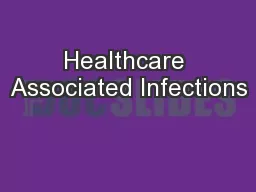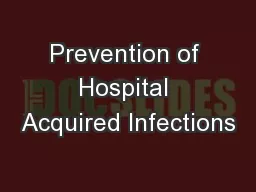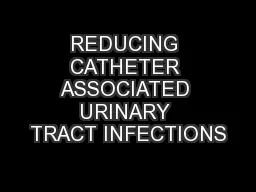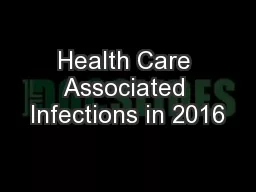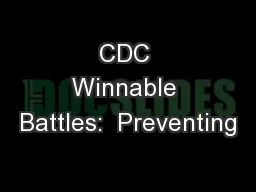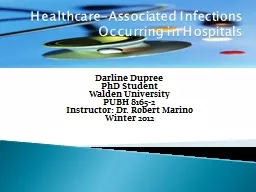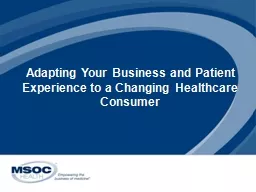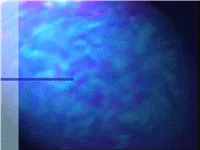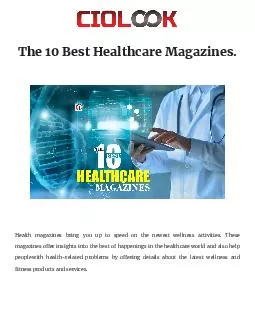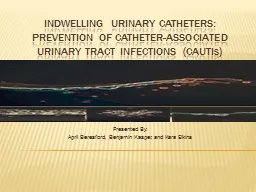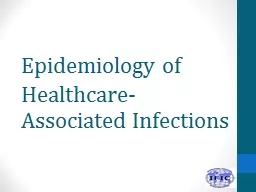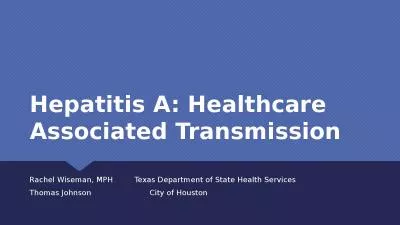PPT-Healthcare Associated Infections
Author : calandra-battersby | Published Date : 2018-09-23
Issues trends and resources for combating the problem Nancy Hudecek RN BSN MS Director Risk Management Patient Safety and Quality Improvement Todays webinar will
Presentation Embed Code
Download Presentation
Download Presentation The PPT/PDF document "Healthcare Associated Infections" is the property of its rightful owner. Permission is granted to download and print the materials on this website for personal, non-commercial use only, and to display it on your personal computer provided you do not modify the materials and that you retain all copyright notices contained in the materials. By downloading content from our website, you accept the terms of this agreement.
Healthcare Associated Infections: Transcript
Issues trends and resources for combating the problem Nancy Hudecek RN BSN MS Director Risk Management Patient Safety and Quality Improvement Todays webinar will begin promptly at 200 PM Central Time. Preventing . Healthcare-Associated Infections (. HAIs. ) . National Center for Emerging and Zoonotic Infectious Diseases. Division of Healthcare Quality Promotion. Healthcare-Associated Infections (. Arya. . Sedehi. ●Eric Esposito● . Lubna. Rashid. What are . HAIs. Develops within 48 hours or more of hospital admission. Related to antibiotic-resistant bacteria. Background. 5-10% of hospitalized patients develop a HAI. CLINICAL EXCELLENCE . COMMISSION. 2014. ACUTE CATHETERISATION INDICATIONS . AND . INSERTION OPTIONS. What’s a CAUTI?. 2. C. atheter . A. ssociated . U. rinary . T. ract . I. nfection (CAUTI). Most common healthcare associated infection (HAI). Acute Care Hospitals. Alfred DeMaria, . Jr., M.D. .. State Epidemiologist. Bureau of Infectious Disease and Laboratory . Sciences. Katherine T. Fillo, . Ph.D, RN-BC. Director . of Clinical Quality Improvement. Healthcare-Associated Infections (. HAIs. ) . National Center for Emerging and Zoonotic Infectious Diseases. Division of Healthcare Quality Promotion. Healthcare-Associated Infections (. HAIs. ). 1 out of 20 hospitalized patients affected. Pasquale Demitrio | Healthcare and Life Sciences. What are the reasons we humidify in Healthcare?. B. C. D. A. What studies do we have? Anything new? . Dry building syndrome: M. icrobes, Humans, Hospitals. nfections . O. ccurring . in . Hospitals. Darline. Dupree. PhD Student. Walden University. PUBH 8165-2. Instructor: Dr. Robert Marino. Winter 2012. Hospital Board of Directors. OSHA. County Public Health Departments. Patients as Consumers Customers of Healthcare What’s happening to healthcare … What is moving us along this paradigm… 2017 Trends New …now fear of regulatory changes Retail clinics ACA…and all its confusion and impacts Infections. Quality Improvement . NURS 362 Cody Gibo. Sylvia Lee. Meagan . Kubo. Janalynn Rollins. Summery of Problems. HAI’s are a major problem because. This blog lists some of the best healthcare magazines that provide the most relevant information on the latest healthcare industry updates Cauti. S. ). Presented By:. April Beresford, Benjamin Kasper, and Kara Elkins. Problem. Catheter associated urinary tract infections (CAUTI) are the cause of many hospital acquired infections.. Nearly 25% of hospitalized patients are catheterized annually, and 10% of these patients develop . Learning Objectives. Describe the epidemiology of healthcare associated infections (HAI).. Summarise how agent, host and environmental factors affect the occurrence of HAIs.. Outline the types of epidemiologic studies that can be used in HAI epidemiology.. Rachel Wiseman, MPH Texas Department of State Health Services. Thomas Johnson City of Houston. Hepatitis A Overview. Fecal-oral transmission. Vaccine preventable. Vaccine licensed in 1995. 2 doses recommended (and required for school in TX) by age 4-6. Insert LOGO. DISCLAIMER. . This document was developed by the Surveillance Subcommittee (SS) of the Arizona Healthcare-Associated Infection (HAI) Advisory Committee. SS is a multidisciplinary committee representing various healthcare disciplines working to define and categorize the strength of evidence for preventing healthcare-associated infections. Their work was guided by the best available evidence at the time this document was created. .
Download Document
Here is the link to download the presentation.
"Healthcare Associated Infections"The content belongs to its owner. You may download and print it for personal use, without modification, and keep all copyright notices. By downloading, you agree to these terms.
Related Documents

